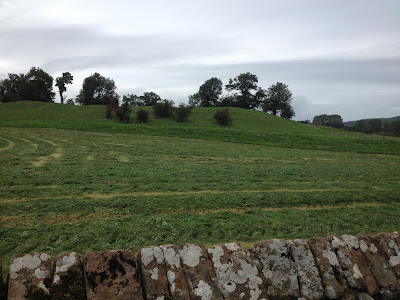Mayburgh Henge, near Penrith on the
edge of the Lake District, is a stunning monument. It was built in the late
Neolithic period and comprises a circular bank of stone, 50 metres wide at its
base, 120 metres in diameter, and surviving to a height of 6 metres. It’s
estimated to contain 20,000 tonnes of stone, probably carried up from the river
Lowther, although it has also been suggested it was reshaped from a natural
glacial deposit.
Mayburgh Henge from the south
The henge is on a knoll of high
ground which gives it a natural dominance over the surrounding area, and it would
have been clearly visible from the surrounding fells before the grass began to cover
it. It’s sited above the confluence of the rivers Eamont and Lowther, and above
the ancient lowland routeway to the north and south, which forded the rivers at
this point. Mayburgh was probably associated with the trade of stone axes,
which were ground from Lake District greenstone and traded across Britain as
far as East Anglia.
The river Lowther, from which
Mayburgh’s stones may have been carried.
The bank’s position and height make
it impossible to see inside the henge, even from the distant fells, except for a
tantalising view of its standing stones visible through the entrance from
several hundred metres away down the hillside. This would have enhanced the mystery
and power of the site for those who travelled by. It gives the impression of a
powerful site and powerful people, a fitting guardian for the entrance into the
hostile mountains where the stone quarries were found.
The view from the entrance. The trees
give an indication of size.
Four standing stones were raised in a
square in the centre of the circle, of which one survives. Four more were present
in the entrance, which faces due east. The stones were destroyed in the 18th
century, after which one of the workmen went insane and another committed suicide.
Damaging once sacred monuments always seems to have a bitter price.
The remaining standing stone,
approximately 3 metres high.
Two other smaller henges were situated
along the river Lowther, a few hundred metres away. King Arthur’s Round Table is
90 metres in diameter and comprises a circular ditch with an outer earthen
bank. Two entrances lay to the south-east and north-west. The latter, which was
flanked with two standing stones, has been destroyed, but would have aligned
directly to the entrance of Mayburgh Henge, much further up the hillside. The second
henge, the Little Round Table, was a similar size and has been entirely
destroyed.
Both these henges lack the feeling of
dominance and power of Mayburgh, and were perhaps used for more mundane work or
trade, with only a select few being allowed up the hillside into the hidden
inner sanctum of the greater henge, which still feels powerful after five
thousand years.
King Arthur’s Round Table






No comments:
Post a Comment